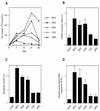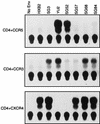Apoptosis induced by infection of primary brain cultures with diverse human immunodeficiency virus type 1 isolates: evidence for a role of the envelope
- PMID: 9882290
- PMCID: PMC103909
- DOI: 10.1128/JVI.73.2.897-906.1999
Apoptosis induced by infection of primary brain cultures with diverse human immunodeficiency virus type 1 isolates: evidence for a role of the envelope
Abstract
Apoptosis of neurons and astrocytes is induced by human immunodeficiency type 1 (HIV-1) infection in vitro and has been demonstrated in brain tissue from patients with AIDS. We analyzed a panel of diverse HIV-1 primary isolates for the ability to replicate and induce neuronal and astrocyte apoptosis in primary human brain cultures. Apoptosis was induced three- to eightfold by infection with the blood-derived HIV-1 isolates 89.6, SG3, and ADA. In contrast, the brain-derived HIV-1 isolates YU2, JRFL, DS-br, RC-br, and KJ-br did not induce significant levels of apoptosis. The ability of HIV-1 isolates to induce apoptosis was independent of their replication capacity. Studies of recombinant chimeras between the SG3 and YU2 viruses showed that replacement of the YU2 Env with the SG3 Env was sufficient to confer the ability to induce apoptosis to the YU2 virus. Replacement of the Env V3 regions alone largely conferred the phenotypes of the parental clones. The SG3 Env used CXCR4 and CCR3 as coreceptors for virus entry, whereas YU2 used CCR5 and CCR3. The V3 regions of SG3 and YU2 conferred the ability to use CXCR4 and CCR5, respectively. In contrast, the 3' region of Env, particularly the C3V4 region, was required in conjunction with the V3 region for efficient use of CCR3. These results provide evidence that Env is a major determinant of neurodegenerative mechanisms associated with HIV-1 infection in vitro and raise the possibility that blood-derived viruses which emerge during the late stages of disease may affect disease progression in the central nervous system.
Figures







References
-
- Adie-Biassette H, Levy Y, Colombel M, Poron F, Natcher S, Keohane C, Gray F. Neuronal apoptosis in HIV infection in adults. Neuropathol Appl Neurobiol. 1995;21:218–227. - PubMed
-
- Bagasra O, Lavi E, Bobroski L, Khalili K, Pestaner J P, Tawadros R, Pomerantz R. Cellular reservoirs of HIV-1 in the central nervous system of infected individuals: identification by the combination of in situ polymerase chain reaction and immunohistochemistry. AIDS. 1996;10:573–585. - PubMed
-
- Brew B J, Evans L, Byrne C, Pemberton L, Hurren L. The relationship between AIDS dementia complex and the presence of macrophage tropic and non-syncytium inducing isolates of human immunodeficiency virus type 1 in the cerebrospinal fluid. J Neurovirol. 1996;2:152–157. - PubMed
Publication types
MeSH terms
Substances
Grants and funding
LinkOut - more resources
Full Text Sources
Other Literature Sources
Research Materials

